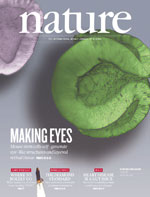Will the future offer artificial retina transplants?
There is a lot of buzz this week about Lucentis versus Avastin for the treatment of wet age-related macular degeneration (AMD), something that will be talked about in more detail at the Association for Research in Vision and Ophthalmology (ARVO) annual meeting this weekend in Fort Lauderdale.
Also on the radar at ARVO is more news from Second Sight and their Argus II Retinal Prosthesis (something that I have previously written about on this blog). For those interested there is a press conference at ARVO on Tuesday, May 3 from 5-6pm.
Second Sight presents updated results from the Argus II Retinal Prosthesis clinical trial, including sentence reading and color vision restoration for previously blind subjects. Two trial participants and independent investigators from the trial will be available for interviews.
 Which brings me back to a Nature article published earlier this month that I have been meaning to write about showing, for the first time, the ability to generate a three-dimensional culture of neural retinal tissue from mouse embryonic stem (ES) cells. A word of warning, you may find the paper a little tough to follow unless you are a scientist in this field.
Which brings me back to a Nature article published earlier this month that I have been meaning to write about showing, for the first time, the ability to generate a three-dimensional culture of neural retinal tissue from mouse embryonic stem (ES) cells. A word of warning, you may find the paper a little tough to follow unless you are a scientist in this field.
Eiraku and colleagues from Japan were able to culture retinal tissue similar to that seen in the human eye. Eye formation starts as an optical vesicle that then develops into a two-walled optic cup. As the authors note “optic cup development occurs in a complex environment affected by neighbouring tissues.”
What the authors showed in their research was the ability to culture retinal tissue containing ganglion cells, photoreceptors and bipolar cells. They conclude:
Collectively, these findings demonstrate that the fully stratified neutral retina tissue architecture in this ES-cell culture self-forms in a spatiotemporally regulated manner mimicking in-vivo development.
My take on this research is that it is an important milestone in regenerative medicine that could lead to the prospect of retinal transplants in the future. I look forward to learning more at ARVO about what the future may hold for retinal transplants derived from human stem cells.
![]() Eiraku, M., Takata, N., Ishibashi, H., Kawada, M., Sakakura, E., Okuda, S., Sekiguchi, K., Adachi, T., & Sasai, Y. (2011). Self-organizing optic-cup morphogenesis in three-dimensional culture Nature, 472 (7341), 51-56 DOI: 10.1038/nature09941
Eiraku, M., Takata, N., Ishibashi, H., Kawada, M., Sakakura, E., Okuda, S., Sekiguchi, K., Adachi, T., & Sasai, Y. (2011). Self-organizing optic-cup morphogenesis in three-dimensional culture Nature, 472 (7341), 51-56 DOI: 10.1038/nature09941